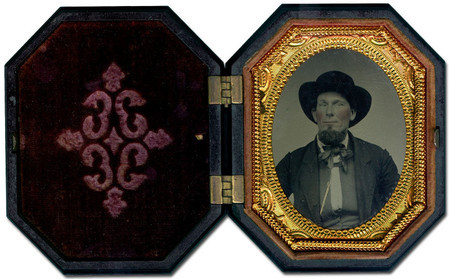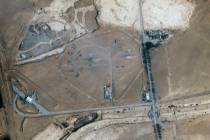Piece of history surfaces: Tintype thought to be of Comstock
CARSON CITY — An 1850s tintype of a man thought to be Henry Comstock, the miner for whom the Comstock Lode was named, has been discovered by a Massachusetts collector and dealer of old photos.
Bill Bohn said he bought the tintype from another photo dealer during a May 10 photo sale in Palmer, Mass.
The seller acquired the photo in an estate sale in Maine, Bohn said, and was aware it might be Comstock but never made any public announcements.
Only one known image of Comstock exists: A grainy photo of him is found in a book published in the 1880s, Bohn said. He declined to say how much he paid for the clear photographic image but did say he will loan it to the Nevada State Museum in Carson City for public display.
"I would like other people to enjoy it," Bohn said in a telephone interview. "If it is Comstock, it is an important discovery."
This year is the 150th anniversary of the discovery of the Comstock Lode. Bohn and the state's Historic Preservation Office are researching whether the tintype image is indeed Comstock.
Tintypes are available for as little as $15 on eBay, but those of more prominent people, such as Frank James, the brother of outlaw Jesse James, are selling for $2,500.
Not many people outside of history buffs are familiar with Henry Comstock, but the Comstock Lode, discovered in June 1859, put the Utah Territory area that would become Nevada on the map and led to statehood in 1864.
Without the Comstock Lode, several historians think that Nevada would not have become a state until the 20th century.
The Comstock Lode is the term for the 19th-century mining district that included Virginia City, Gold Hill, Silver City and nearby areas. In today's prices, $18 billion in silver and gold was extracted from the district. Thousands of miners rushed to Virginia City after the discovery of gold and silver by Patrick McLaughlin and Peter O'Riley.
Comstock didn't make the discovery that led to the mining boom, but he apparently was a good talker and self-promoter. State Historic Preservation Officer Ron James said the mining district took Comstock's name because he was an "assertive braggart."
Comstock showed up at the claim that McLaughlin and O'Riley were developing and insisted it was part of a claim he already held. They ended up giving him a share of the claim. Comstock later sold his share for a few thousand dollars. He left Virginia City and wandered the West looking for another strike.
In 1870, he committed suicide while living in Montana. By that time, Comstock was broke and considered insane.
Bohn maintains a Web site, oldphotographic.com, where he discusses his find and shows the striking facial matches between the bearded man on his tintype and the only known photograph of Comstock.
He and James hope people who might have other photographs of Comstock or knowledge of the miner will contact them.
"We hope that by announcing this discovery, additional information may be forthcoming," James said. "If this is, in fact, Henry Comstock, we are able, for the first time, to see a clear image of the man who shaped industrial history and was known throughout the nation."
Bohn can be reached by e-mail at admin@oldphotographic.com. James can be reached at the Department of Cultural Affairs at 775-687-8323.
Contact Review-Journal Capital Bureau Chief Ed Vogel at evogel@reviewjournal.com or 775-687-3901.




























